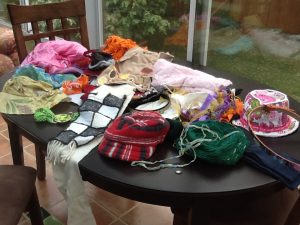Psssst. Check out the book giveaway at the end and enter by Oct. 31!
A quick story as we explore the benefits of everyday prototyping:
While on a work trip to Japan several years ago, my healthcare colleagues and I studied how lean thinking quality improvement works in manufacturing. We were taught by a Japanese sensei with deep, deep knowledge.
Our training included working on a manufacturing floor identifying examples of wasteful practices and potential solutions. We also had to prototype our ideas on the fly. This could include acting out a new flow of production steps that seemed more logical. Or we might use materials like cardboard, tape and other doodads to mock up a device or equipment idea.
My team had an idea to help sort small equipment parts better off one section of the assembly line. Our sensei told us to create a rough example and asked how long we needed to show it to him. We guessed an hour. He told us he’d be back in 10 minutes.
No! we protested. We need more time.
“The faster you try, the faster you learn,” he barked on his way to tutor another stressed team.
We scrambled to make a very ugly cardboard example of the idea. We could see problems within a few minutes. By the time he came back with that knowing look, we were already identifying how we thought the idea might work better with more iterations.
Everyday Prototyping
The faster you try, the faster you learn has stayed with me ever since. You might also hear phrases such as fail forward fast.
Prototyping is when we take an idea from our head or a document (let’s call it 2D) and turn it into a 3D object we can hold or an interactive experience. It could involve sketching, drawing, building or role playing.
I shared a work example above, but I have examples of everyday prototyping from my writing and home life, too. You might calls these life hacks, creative hacks, simulations or something else, too. Another popular phrase, at least in the corporate/manufacturing world, is to get your hands dirty. In other words, stop talking and start trying.
When authors get together, they’re less likely to share their horoscope sign and more likely to share whether they’re a plotter or a pantser. Plotters put a fair amount of effort into planning out a new book before starting the serious writing. Pantsers may have some elements thought through but dive in faster, letting the details emerge as they go.
There’s a time for both approaches, of course. But let’s lean into being a pantser for everyday creative problem solving, especially when it comes to everyday prototyping in its various forms.
Another brief story:
When I took on some middle grade arts and crafts book projects several years ago, rapid prototyping became critical. My deadlines were aggressive as I worked to produce viable ideas and clear, age-appropriate instructions.
Our sunroom and kitchen table became my messy workshop as I experimented with various materials and dozens of ideas. I literally got my hands dirty with glue, paint, tape, mod podge and whatever else as I tried to create fun craft projects for tweens out of unusual materials.
Sometimes I quickly abandoned an idea from my brainstormed list. Sometimes I saw enough promise to work it through, documenting steps as I figured it out.

Just a few of my craft prototypes in our sunroom, messy craft supplies cleaned up or off to the side, I can’t remember. This involved prototyping on steroids!
Through this, I learned that I needed at least double the number of ideas as final projects. More is better. Many of the ideas simply did not work out as hoped, or they were rejected down the road. (If you’re into arts and crafts, you can check out the resulting books on my Books page.)
Everyday Problems
Build to think is a common mantra in the product design world. It works for everyday problems, too. Everyday prototyping help us build to think to get unstuck.
Just a few examples from my life:
- Role playing all the time with my youngest daughter to help her practice challenging social situations.
- Mocking up all sorts of behavior support tools over the years, always starting with paper and pencil.
- Fishing through the tools drawers in the garage to create my own curtain hangers for a certain room when I got tired of searching to buy a product that would do the trick.
- Using binder clips for everything except their intended purpose — can we pause and praise the magic of binder clips?
- My husband rigging up a super cheap way to divert rainwater after we dealt with a flooded basement and faced quotes for several thousand dollars to do bigger repairs that seemed like overkill.
- Creating paper mockups of a picture book to figure out the flow across the pages and refine the story (a common practice among picture book authors and illustrators).

Here’s my scritch scratch for a simplified computer folder structure when I recently inherited dozens and dozens of work files in a long string of folders that had me completely overwhelmed (I then went back and forth with a colleague using this rough sketch before touching the electronic system).
I bet you have your own list of things you’ve done or problems that could use some hands-on solutions.
Common Pitfalls
Take note. There are some things we might need to get over so we can actually reap the benefits. These include:
- Thinking an idea is so simple and straightforward that mocking it up is a waste of time. Even “simple” ideas can yield surprises when you go beyond just thinking and talking about it.
- Wanting to make it look slick before showing anyone.
- Feeling silly about role playing and trystorming.
- Feeling the need to over-explain an idea and how to use it rather than just watching how it works or doesn’t without extra help.
- Hopping on the computer right away to create digital mockups.
Resources to Help
Here are a few web resources and articles to help get those creative juices flowing.
- Why Everyone Can Benefit from Prototyping (Not Just Designers) (article with video)
- What Cooking Dinner for Friends Taught Me About Prototyping (article)
- Prototyping Your Life (1-hour video with interesting twist on how to prototype changes about the direction of your life)
- 65+ Ridiculously Ingenious & Easy Life Hacks(article)
- 100 Genius Solutions To Everyday Problems You Didn’t Know Existed (article)
And check out the creativity resources on my website
Already a master at everyday prototyping? Share a example or two. Intrigued? Give it a try. Just remember to park perfection as you try your own ideas and encounter other people’s idea experiments.
As sensei says: the faster you try, the faster you’ll learn!
And a post script: I’d be remiss if I didn’t highlight that people living in impoverished parts of our world or living in conflict/war zones often are masters at this out of necessity. UNICEF calls this frugal innovation. I would like to explore this topic in more depth in a future post.

Great article! I already know that “the faster you try, the faster you learn” is going to stick with me too!